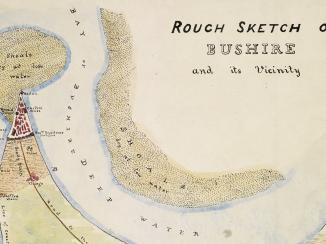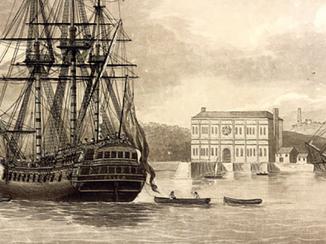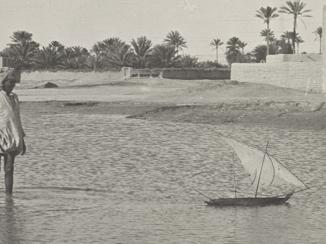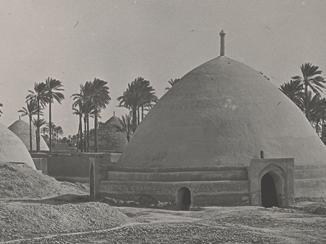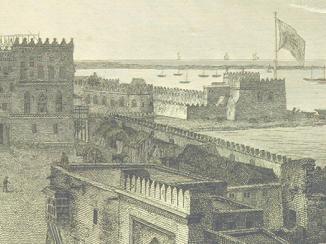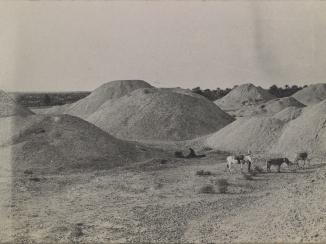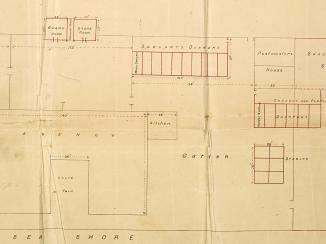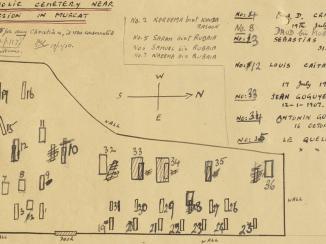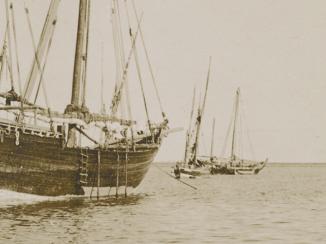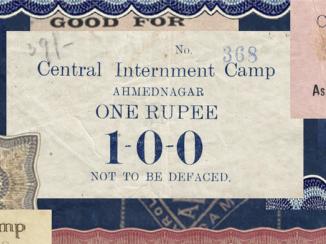Overview
The creation of the Bahrain Agency
The IOR/R/15/2 Series contains the records of the Bahrain Agency An office of the East India Company and, later, of the British Raj, headed by an agent. . The East India Company had considered setting up a post in Bahrain in 1750, and there had been a Native Agent Non-British agents affiliated with the British Government. stationed on the island from the 1820s, but the Agency An office of the East India Company and, later, of the British Raj, headed by an agent. itself was not formally established until 1900. The Native Agent Non-British agents affiliated with the British Government. had reported to the British Resident at Bushehr, and so records relating to Bahrain before the establishment of the Agency An office of the East India Company and, later, of the British Raj, headed by an agent. can be found in the IOR/R/15/1 Series, as well as elsewhere in the India Office The department of the British Government to which the Government of India reported between 1858 and 1947. The successor to the Court of Directors. Records. A portion of the files from the IOR/R/15/2 Series is now available on the QDL.
The creation of the Agency An office of the East India Company and, later, of the British Raj, headed by an agent. was prompted primarily by fear of Ottoman and French influence in the Gulf region. However, other considerations included the unpopularity of the then Native Agent Non-British agents affiliated with the British Government. , Agha Muhammad Rahim, and the prospect of attracting more British businesses to the island. An opportunity for establishing the Agency An office of the East India Company and, later, of the British Raj, headed by an agent. came in 1898 when Shaikh Isa bin Ali Al Khalifa of Bahrain asked the British to recognise his son Hamad as his successor. In return, he agreed to the appointment of a British Agent, and John Calcott Gaskin subsequently took up the post as the first Political Agent A mid-ranking political representative (equivalent to a Consul) from the diplomatic corps of the Government of India or one of its subordinate provincial governments, in charge of a Political Agency. in Bahrain.

Staffing and responsibilities of the Agency
As its importance grew after the First World War, the Bahrain Agency An office of the East India Company and, later, of the British Raj, headed by an agent. increasingly suffered from a shortage of clerical staff. The existence of the British air and naval bases, and the operations conducted by oil companies, all led to an increased workload for the Agent. In 1924, an Assistant Political Agent A mid-ranking political representative (equivalent to a Consul) from the diplomatic corps of the Government of India or one of its subordinate provincial governments, in charge of a Political Agency. was temporarily appointed, and would be periodically present on the island over the next ten years. From 1934 to 1945, the Assistant was continually present, although he officially remained a temporary appointee.
In 1934, the Agency An office of the East India Company and, later, of the British Raj, headed by an agent. was given responsibility for the Trucial Coast A name used by Britain from the nineteenth century to 1971 to refer to the present-day United Arab Emirates. (precursor of the modern United Arab Emirates), and so the records contain correspondence with the British representative at Sharjah. After 1938, Qatar also became a special mission of the Agent at Bahrain. Previously, it been supervised from Bushehr by the Resident in the Persian Gulf The historical term used to describe the body of water between the Arabian Peninsula and Iran. .
The Agency An office of the East India Company and, later, of the British Raj, headed by an agent. was under the control of the Government of India until the First World War when, together with the Agency An office of the East India Company and, later, of the British Raj, headed by an agent. in Kuwait, it was placed under Sir Percy Cox, the Chief Political Officer in Mesopotamia. After the war, matters concerning Ibn Saud remained subject to the Colonial Office, but control over most other matters reverted to the Government of India. In 1933, the India Office The department of the British Government to which the Government of India reported between 1858 and 1947. The successor to the Court of Directors. resumed control of the Agency An office of the East India Company and, later, of the British Raj, headed by an agent. in its entirety.
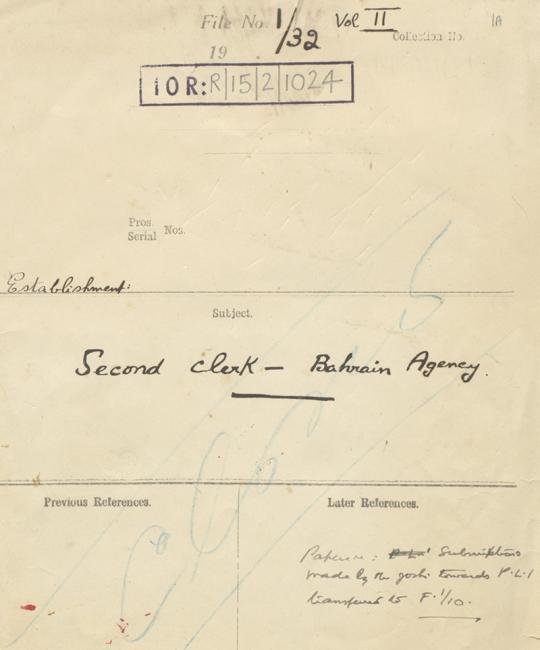
Subject matter
The majority of the files contain correspondence, along with related maps and reports. The Agent corresponded with his superiors in India, his subordinates, and other British and local officials, such as agents in the Trucial Coast A name used by Britain from the nineteenth century to 1971 to refer to the present-day United Arab Emirates. , and those who helped him to run the Agency An office of the East India Company and, later, of the British Raj, headed by an agent. . He also cooperated and communicated with other relevant British authorities, including military and naval commanders, non-British authorities such as local rulers, and corporations with interests in the region, particularly oil companies active in Bahrain and the Gulf.
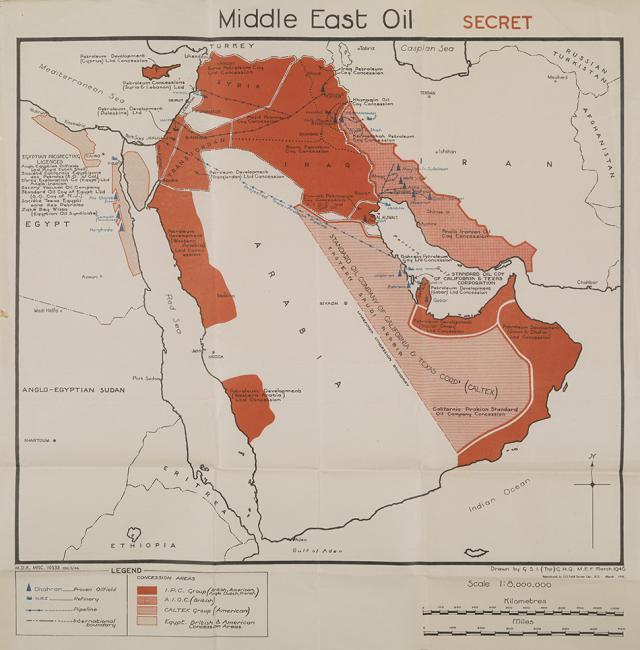
There are also examples of non-correspondence material, including reports on administration, social conditions, and economic affairs. For instance, IOR/R/15/2/1543 contains reports on the occurrence of locust swarms in Bahrain from 1945/6 to 1948.
The subject material is wide-ranging, and includes information on boundary disputes, imports and trade, the oil industry, emancipation and manumission, and shipping.
Organisation of the files
The recordkeeping at the Bahrain Agency An office of the East India Company and, later, of the British Raj, headed by an agent. was similar to the processes followed in other Agencies. Each subject was numbered, as were the files within that subject. This system is sometimes apparent in the titles of files, such as IOR/R/15/2/1689, which is entitled ‘File 22/1 I Miscellaneous correspondence regarding establishment of observatory at Bahrain’. The ‘22/1’ refers to the fact that it is the first file concerned with the Bahrain meteorological observatory.
There were three separate offices in the Agency An office of the East India Company and, later, of the British Raj, headed by an agent. : English, Vernacular, and Confidential. This division is preserved in the sequence of the files. The Confidential and English Offices covered a broad range of overlapping subjects, while the Vernacular Office dealt mainly with consular and judicial business, translated and occasionally summarised incoming documents for the Political Agent A mid-ranking political representative (equivalent to a Consul) from the diplomatic corps of the Government of India or one of its subordinate provincial governments, in charge of a Political Agency. , and drafted Arabic-language responses for his approval.
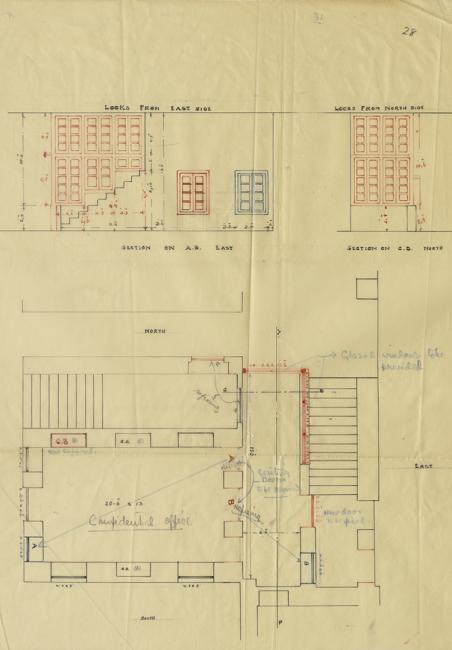
The Political Agent A mid-ranking political representative (equivalent to a Consul) from the diplomatic corps of the Government of India or one of its subordinate provincial governments, in charge of a Political Agency. was empowered to run his own judicial court, and the records of the court are contained in Series IOR/R/15/3 (not currently available on QDL), although some associated material is also contained in the records of the Vernacular Office.
The IOR/R/15/2 Series is arranged as follows:
IOR/R/15/2/1-945 are the Confidential Office files
IOR/R/15/2/946-1823 are the English Office files
IOR/R/15/2/1824-1980 are the Vernacular Office files
IOR/R/15/2/1981-1990 are documents not under the previous three headings, mostly financial accounts of the Agency An office of the East India Company and, later, of the British Raj, headed by an agent.
IOR/R/15/2/1991-1997 are Government of India official publications dating from 1916-1923
IOR/R/15/2/1998-2022 are files out of sequence, as they were transferred to the India Office The department of the British Government to which the Government of India reported between 1858 and 1947. The successor to the Court of Directors. after the other files.
FURTHER READING
Hugh Arbuthnott, Terence Clark, and Richard Muir, British Embassies around the Gulf 1575-2005 (Folkestone: Global Oriental, 2008)
James Onley, The Arabian Frontier of the British Raj: Merchants, Rulers, and the British in the Nineteenth-Century Gulf (Oxford: Oxford University Press, 2007)
James Onley, ‘Britain's Native Agents Non-British agents affiliated with the British Government. in Arabia and Persia in the Nineteenth Century’, Comparative Studies of South Asia Africa and the Middle East 24.1 (2004), 131–141
Penelope Tuson, The Records of the British Residency An office of the East India Company and, later, of the British Raj, established in the provinces and regions considered part of, or under the influence of, British India. and Agencies in the Persian Gulf The historical term used to describe the body of water between the Arabian Peninsula and Iran. . IOR R/15 (London: India Office The department of the British Government to which the Government of India reported between 1858 and 1947. The successor to the Court of Directors. Records, 1979)
